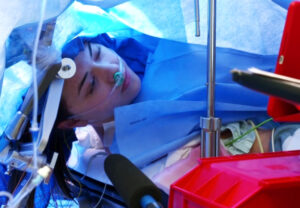 Surgery is one of the most common treatments for brain cancer. The goal of surgery is usually to remove as much of a tumor as possible without damaging healthy brain tissue. Removing the tumor helps take pressure off your brain and may help alleviate your symptoms.
Surgery is one of the most common treatments for brain cancer. The goal of surgery is usually to remove as much of a tumor as possible without damaging healthy brain tissue. Removing the tumor helps take pressure off your brain and may help alleviate your symptoms.
The following is an overview for the surgical treatment brain cancer cancer. The information on this web-site is intended to help educate you about your treatment options and to create discussion to help in the decision-making process with your treatment team.
Cancer can develop in many different parts of your brain. Surgery is usually only an option if the tumor is small, easily accessible, and hasn’t spread from other parts of your body. There are more than 130 different types of brain tumors known today. The best treatment option will depend on the type and location of your tumor.
Surgery is one of the five multidisciplinary treatments used to treat brain cancer along with:
- active surveillance
- radiation therapy
- chemotherapy and immunotherapy
- targeted therapy
- surgery
Surgery is often the first treatment for brain cancer. It’s used to remove a tumor or slow its growth. In some cases, even removing part of the tumor may help improve your symptoms. Radiation or chemotherapy are often given after surgery to destroy any remaining cancer cells. Radiation therapy or chemotherapy may be combined with surgery to kill any cancer cells that may not have been removed through surgery.
GammaTile® is an FDA-cleared radiation treatment that is specifically designed for use inside the brain to give patients immediate and targeted radiation after the tumor is removed during surgery.
Types of surgery for treating brain cancer
The most common types of surgical procedures used to treat brain cancer include:
- Biopsy. A biopsy is when a small tissue sample is taken to be analyzed under a microscope. This helps doctors figure out whether a tumor is cancerous and what type of cancer it is.
- Craniotomy. A craniotomy involves the surgical removal of part of your skull to let surgeons operate on your brain and remove the tumor.
- Endonasal endoscopy. During an endonasal endoscopy, a surgeon accesses the brain through the nose with a thin tube called an endoscope.
- MRI-guided laser ablation. MRI-guided laser ablation is a minimally invasive surgery that involves making a small hole in your skull and inserting a fiber-optic laser. Surgeons then use heat from the laser to destroy cancer cells.
- Neuroendoscopy. A small section of your skull is removed to insert a thin tube called an endoscope. This is used to treat conditions like obstructive hydrocephalus, hematomas, and skull based tumors.
Surgical procedure
The surgical procedure used to remove a brain tumor depends on the type of tumor you have. But you’ll likely:
- undergo a biopsy where the doctor takes a small tissue sample of your tumor
- have a presurgical assessment where you meet your treatment team a week or two before the surgery
- have a doctor or nurse give you specific instructions, like when to stop drinking or eating before surgery
- have an opportunity to ask any questions you may have about the procedure
- need to take steroids a few days before the surgery to reduce swelling in your brain
What are the possible risks of brain surgery?
Every surgery comes with some risk. General surgery risks include:
- bleeding
- infection
- deep vein thrombosis
- urinary retention
- anesthesia reaction
- scarring
Brain surgery comes with additional risks due to the risk of damaging brain tissue or other structures in your head. The possible risks include:
- balance issues
- facial nerve damage
- damage to your sinuses
- brain fluid leak
- memory problems
- muscle weakness
- paralysis
- speech problems
- seizures
- stroke
- coma
One of the major concerns of brain cancer surgery is swelling in your brain. Swelling can put pressure on your brain that can cause your symptoms to worsen or cause long-term brain damage. Corticosteroids are often given to limit swelling.
What is recovery like?
The timeline of your recovery process depends on factors like the type of surgery you have, the extent of the procedure, and the side effect you experience.
After your procedure, you’ll be taken to the recovery unit or intensive care unit to be monitored. Once you’re stable, you can expect to stay in the hospital for about a week. You’ll be given a urinary catheter for several days, and you’ll have regular neurological checkups.
After returning home, you’ll likely need time off from work and may experience tiredness for up to 6 weeks. Some people recover within a couple of weeks, while others may need months or never fully recover.
You’ll likely have some amount of swelling after surgery. This swelling may cause temporary side effects like headaches, nausea, and poor balance.
During your recovery, it’s a good idea to:
- exercise regularly, as recommended by your doctor, to maintain your health and decrease your risk of blood clots
- eat healthy
- increase your activity level slowly
- get plenty of rest
- avoid consuming alcohol and smoking
- avoid driving until your doctor says you can
- have someone check your wounds every day for the first couple of weeks
- avoid direct heat to your head for a couple of weeks
What types of follow-up care might I need after brain surgery?
You may need several types of follow-up care after brain surgery.
Physical, occupational, or speech therapy
You may benefit from physical, occupational, or speech therapy for weeks to months after your surgery.
Physician follow-ups
You’ll need to follow up with your doctor after your surgery to make sure you remain cancer-free. Follow-ups for aggressive cancers are usually scheduled every 3 to 6 months for the first 5 years and then once per year. You may only need to follow up every 6 to 12 months for the first 5 years and then every year or two for less aggressive cancers.
During your follow-up appointments, your doctor will perform a neurological exam to monitor your symptoms and may order imaging tests like MRI or CT scans to check for any signs of your cancer returning.
Medications
You’ll likely be given medications to take in the weeks after your surgery. You may require additional follow-ups with your doctor if these medications aren’t effective or cause side effects.
- Phentyoin is often prescribed to reduce your risk of seizure.
- Lactulose may be prescribed to prevent constipation.
- You may be given the corticosteroid dexamethasone to reduce swelling in your brain.
- Pain killers may be prescribed, like paracetamol, codeine phosphate, and diclofenac.




